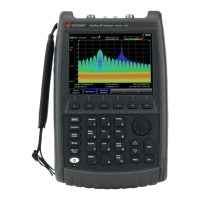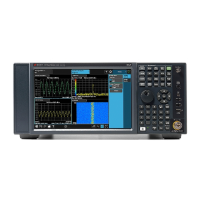Keysight FieldFox Handheld Analyzers Service Guide 81
Theory of Operation
Operation in Modes
The RF In Atten can be set from 0 through 30 dB in 5 dB steps. The Attenuator
Slope Adjustment determines the correction factors for each step in each
frequency band.
The RF In Atten can be controlled manually or automatically. When in auto
mode, the Reference Level setting determines the attenuator setting.
The Pre-amp can be in or out. Nominal gain of the pre-amp is 22 dB.
The “Attn” and “PA” indicators in the display header give current status. The
Scale/Amptd hard key provides access to control for them.
The displayed measured value for a given signal is automatically compensated
for in the current Attn and PA settings. For instance, if an incoming signal is
measured at -70 dBm with the RF IN Atten set to 5 dB and PA “out”, changing
to PA “in” will give a measured value of approximately -70 (+/- because the
22 dB for the PA is only nominal). The difference seen in the trace will be that
the noise floor of the trace will be lowered by approximately 22 dB. If the RF In
Atten is changed from 5 dB to 15 dB, the measured value will not change
significantly (still approximately -70 dBm) but the noise floor will raise by
10 dB.
SA has two basic modes: step and FFT.
Step mode reads a narrow slice of the spectrum and the LO steps for each
slice. In this mode, a trace on the display is composed from multiple slices.
Generally spans greater than 100 kHz operate in step mode.
FFT mode reads a wide slice of the spectrum and the LO is fixed. In this mode,
a trace on the display is based on a single LO setting.
The LO minimum step size is 2 MHz; this restriction limits spurs.
The hardware operation of the A/D’s is essentially the same for both step and
FFT modes. The difference is the digital signal processing.
The SA adjustments generally correct the gain with 11 frequency bands. See
page 5-64 for a listing of the 11 bands. See the TME help file for details on SA
adjustments.
Power Meter Mode
All measurement circuitry is switched to the low power state during PM (power
meter) mode. This is the mode with the lowest power dissipation.
The analyzer has no power output capability in this mode. The analyzer
essentially functions as a display for a USB power sensor.

